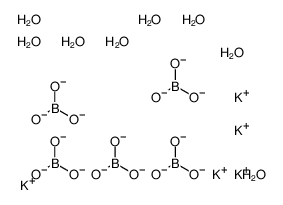12229-13-9
| Name | pentapotassium,pentaborate,octahydrate |
|---|---|
| Synonyms |
Potassium pentaborate octahydrate
Boron potassium oxide (B5KO8),tetrahydrate POTASSIUM PENTABORATE OCTAHYDRATE,97 MFCD00213879 |
| Melting Point | 780ºC |
|---|---|
| Molecular Formula | B5H16K5O23 |
| Molecular Weight | 633.66000 |
| Exact Mass | 633.87300 |
| PSA | 419.74000 |
|
Section 1: Product Identification Chemical Name:Potassium pentaborate octahydrate, 97% CAS Registry Number:12229-13-9 Formula:K2B10O16.8H2O EINECS Number:none Chemical Family:organic or inorganic borate Synonym:none
Section 2: Composition and Information on Ingredients IngredientCAS NumberPercentACGIH (TWA)OSHA (PEL) Title Compound12229-13-9100%10mg/m315mg/m3 Section 3: Hazards Identification Dust may be irritating to eyes and respiratory tract. Ingestion of large amounts of soluble borates may cause Emergency Overview: toxic effects. Primary Routes of Exposure:Ingestion, Inhalation of dust. Eye Contact:May cause mild to moderate irritation of the eyes Skin Contact:May cause slight to mild irritation of intact skin. Irritation is greater if broken skin is exposed. Inhalation:Dust may be irritating to the nose, mucous membranes and respiratory tract. Soluble borates, if ingested in large quantity, may cause twitching of facial muscles, diarrhea, kidney damage, Ingestion: shock and coma. Acute Health Affects:May be irritating to broken skin, eyes and respiratory tract. Repeated exposure to small amounts has not been associated with long term chronic effects. Large repeated Chronic Health Affects: exposure to some boron compounds has reportedly resulted in weight loss, skin rash, and anemia. NTP:No IARC:No OSHA:No SECTION 4: First Aid Measures Immediately flush the eyes with copious amounts of water for at least 10-15 minutes. A victim may need Eye Exposure: assistance in keeping their eye lids open. Get immediate medical attention. Wash the affected area with water. Remove contaminated clothes if necessary. Seek medical assistance if Skin Exposure: irritation persists. Remove the victim to fresh air. Closely monitor the victim for signs of respiratory problems, such as difficulty Inhalation: in breathing, coughing, wheezing, or pain. In such cases seek immediate medical assistance. Seek medical attention immediately. Keep the victim calm. Give the victim water (only if conscious). Induce Ingestion: vomiting only if directed by medical personnel. SECTION 5: Fire Fighting Measures Flash Point:no data Autoignition Temperature:no data Explosion Limits:no data Extinguishing Medium:none required Special Fire Fighting Procedures:No special fire fighting procedures required. Hazardous Combustion andIf involved in a fire this material may emit irritating dusts. Decomposion Products: Unusual Fire or Explosion Hazards: No unusual fire or explosion hazards. SECTION 6: Accidental Release Measures Small spills can be mixed with vermiculite, sodium carbonate or other suitable non combustible adsorbent and Spill and Leak Procedures: swept up. SECTION 7: Handling and Storage Handling and Storage:Store the material in a tightly sealed container in a cool, dry place. SECTION 8: Exposure Controls and Personal Protection Eye Protection:Always wear approved safety glasses when handling a chemical substance in the laboratory. Skin Protection:Wear appropriate chemical resistant gloves and clothing. Ventilation:Material may form a fine dust. If possible, handle the material in an efficient fume hood. If in form of fine dust and ventilation is not available a respirator should be worn. The use of respirators Respirator: requires a Respirator Protection Program to be in compliance with 29 CFR 1910.134. Ventilation:Material may form a fine dust. If possible, handle the material in an efficient fume hood. Additional Protection:No additional protection required. SECTION 9: Physical and Chemical Properties Color and Form:white powder Molecular Weight:442.30 (586.43) Melting Point:780° Boiling Point:no data Vapor Pressure:not applicable Specific Gravity:no data Odor:none Solubility in Water:.007g/100cc (0C) SECTION 10: Stability and Reactivity Stability:air and moisture stable Hazardous Polymerization:no hazardous polymerization Conditions to Avoid:none Incompatibility:active metals Decomposition Products:boron oxide and potassium oxide SECTION 11: Toxicological Information RTECS Data:No information available in the RTECS files. Carcinogenic Effects:no data Mutagenic Effects:no data Tetratogenic Effects:no data SECTION 12: Ecological Information Ecological Information:No information available SECTION 13: Disposal Considerations Disposal:Dispose of according to local, state and federal regulations. SECTION 14: Transportation Shipping Name (CFR):Non-hazardous Hazard Class (CFR):NA Additional Hazard Class (CFR):NA Packaging Group (CFR):NA UN ID Number (CFR):NA Shipping Name (IATA):Non-hazardous Hazard Class (IATA):NA Additional Hazard Class (IATA):NA Packaging Group (IATA):NA UN ID Number (IATA):NA SECTION 15: Regulatory Information TSCA:Not listed in the TSCA inventory SARA (Title 313):Title compound not listed Second Ingredient:none SECTION 16 - ADDITIONAL INFORMATION N/A |
